Conversational agents (aka "bots"): an overview

Introduction
Conversational agents or in short Bots are interfaces emulating a conversation with the user via textual entry or speech, typically to carry out some action. This field has seen some recent interest and there were multiple announcements from major players, probably spurred by the ubiquity of mobile computing and chat-based communication platforms which are becoming ever more prominent (Slack, What’s App, etc.) and the improvements in speech recognition.
Intent
A typical query to such a bot system is Could you please book me a flight to London? The first task for the system is to determine the intent of the query, i.e. mapping a phrase to a specific action that it can fulfill. Along with the intent, it’s necessary to extract the action parameters from the phrase, and if missing, ask for them.
Parameters, also called entities, often belong to types which are universal to such applications (e.g. Location, Datetime, number, contact, distance, duration, etc.) and some other more specific entities which have to be defined, typically enumerations (e.g. types of pizza, etc.).
Interaction
Below a typical interaction with such a system:
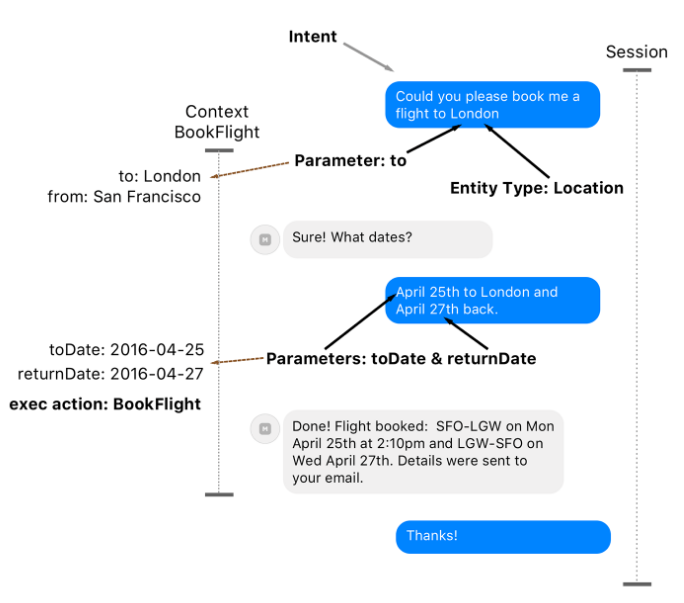
A session represents one conversation from beginning to end. The context stores the intermediate states and parameters from previous expressions during the dialogue. Multiple contexts can be present within a session, e.g. to query the user’s calendar for suitable flight times or send a personalized email.
The main NLP-related tasks of such systems are:
- Determining the Intent: this is a classification problem and is typically done using training-based machine learning methods (e.g. logistic regression). The system therefore requires a initial training set.
Even with a small initial set however, results can be good if actions are unambiguous and easy to characterize by some keywords (e.g. in the book a flight example above, the presence of the flight keyword has a lot of weight and will make the classification succeed in most cases, especially if the only thing that the system can do with flights is book them).
Such systems allow progressive refinement of the classification through the administration interface as users start formulating queries in production (also known as Active Learning).
- Parameter extraction: this is a well described problem in statistical NLP which is known as Named Entity Recognition. It is a classification problem which looks at the sequence of tokens in the input and is typically solved using Conditional Random Fields(CRF)
Systems overview
LUIS (Microsoft)
LUIS was introduced during BUILD 2016 together with Microsoft BotFramework and the Skype Developer Platform. It is part of the Microsoft Cognitive Services suite.
Below some examples of configuration for a flight booking service such as the one described in the introduction.

The dialogue to add a new intent allows defining parameters and entity types for these parameters, as well as their “Required” status. Required parameters trigger an additional question when missing, which can also be configured.
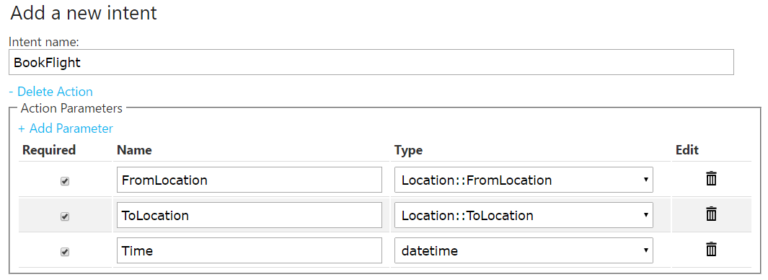
Training the system works by typing in a sample query and confirming the intent as well as pointing out entities in the text.

The service exposes a REST API which allows building applications with it or connecting it to a Skype Bot. Here an example response for book a flight from geneva to london tomorrow
{
"query": "book a flight from geneva to london tomorrow ",
"intents": [
{
"intent": "BookFlight",
"score": 1.0,
"actions": [
{
"triggered": true,
"name": "BookFlight",
"parameters": [
{
"name": "FromLocation",
"required": true,
"value": [
{
"entity": "geneva",
"type": "Location::FromLocation",
"score": 0.9842492
}
]
},
{
"name": "ToLocation",
"required": true,
"value": [
{
"entity": "london",
"type": "Location::ToLocation",
"score": 0.956707537
}
]
},
{
"name": "Time",
"required": true,
"value": [
{
"entity": "tomorrow",
"type": "builtin.datetime.date",
"resolution": {
"date": "2016-06-22"
}
}
]
}
]
}
]
},
{
"intent": "None",
"score": 0.03487882
},
{
"intent": "GetWeather",
"score": 6.479705E-08,
"actions": [
{
"triggered": false,
"name": "GetWeather",
"parameters": [
{
"name": "Location",
"required": true,
"value": null
}
]
}
]
}
],
"entities": [
{
"entity": "geneva",
"type": "Location::FromLocation",
"startIndex": 19,
"endIndex": 24,
"score": 0.9842492
},
{
"entity": "london",
"type": "Location::ToLocation",
"startIndex": 29,
"endIndex": 34,
"score": 0.956707537
},
{
"entity": "tomorrow",
"type": "builtin.datetime.date",
"startIndex": 36,
"endIndex": 43,
"resolution": {
"date": "2016-06-22"
}
}
]
}
Facebook Wit.ai
Wit.ai was acquired by Facebook in January 2015. The development environment is quite elaborate and revolves around the idea of building conversations around stories. They have a cool demo with home automation and speech recognition of commands here.
DialogFlow
DialogFlow (formerly Api.ai) was created by a team who has built a personal assistant app for major mobile platforms with speech and text enabled conversations. The interesting thing is that DialogFlow has built-in domains of knowledge (Intents with Entities and even suggested Replies) on topics like small talk, weather, apps or even wisdom. It means that agents can recognize these intents without any additional training – and can even provide pre-built responses. There are up to 35 different domains with full English support and partial support for the other six languages.
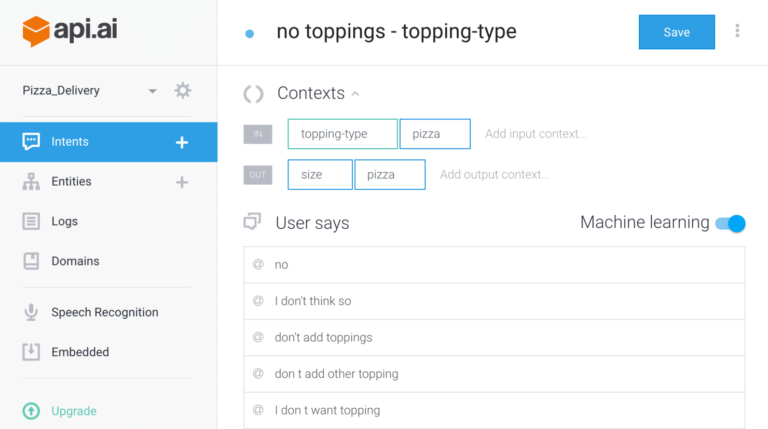
Amazon Alexa
Alexa is the technology powering the Amazon Echo. In that ecosystem, bots are known as skills and new skills can be developed by anyone using the Alexa Skills Kit. Skills are subject to an approval process before they can be made available to everyone, but the pay-off can be interesting as the community of Alexa users is growing every day (through Amazon devices for the household).
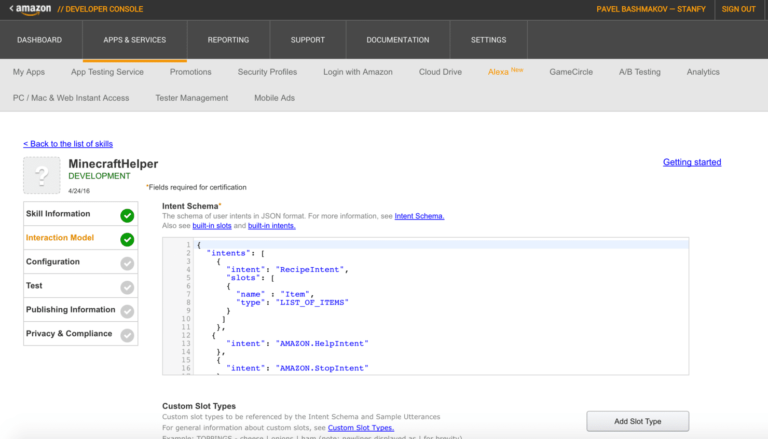
Cortana, Siri
No need to present those [icon name=”smile-o” class=”” unprefixed_class=””] Cortana is probably based on similar technology as LUIS to determine intents and parameters. Cortana is promising in that it benefits from an infrastructure that allows reacting to various events occurring in the cloud, such as varying traffic conditions. In theory this allows notifying the user who’s interested in catching a flight that he needs to leave earlier. But unfortunately it has become available only progressively in various regions, with various degrees of support for online services, and typically in Windows 10 it’s been suffering from various bugs.
Viv (Siri 2.0)
Viv is Siri’s creator Dag Kittlaus latest startup. It is still under development and little is known about its real capacities (first demo), but it aims at going beyond this simple scheme of single intent with parameters. For example, I want to pick up a Pizza on the way to my girl friend's house and I would like to find a perfect wine to pick up along the way. Also I would like to bring her flowers. Actions behind the intent of this paragraph are manifold and it requires an understanding of who is the girlfriend, where she lives, knowing about pizzerias, flowers and wine shops (and possibly even wine).
Here’s an exerpt from the patent:
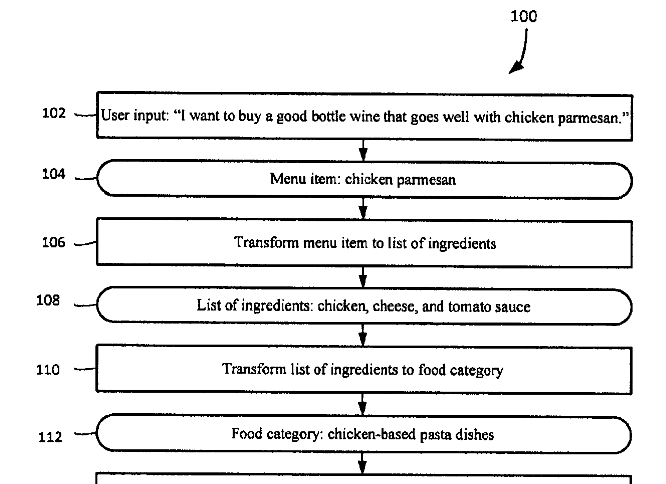
The system forms the intent of the user as seeking a wine recommendation based on a concept object 104 for a menu item, chicken parmesan. Since no single service provider offers such a use case, the system creates a plan based on the user’s intent by selecting multiple action objects that may be executed sequentially to provide such a specific recommendation service.
Even though the system has not been intentionally designed to create wine recommendations based on a name of a menu item, it is able to synthesize a way of creating such recommendation based on concept objects and action objects. Although this illustrates an example of a system creating a single plan with a linear sequence that includes three action objects and four concept objects, the system creates multiple plans. Each plan may include any combination of linear sequences, splits, joins and iterative sorting loops, and any number of action objects and concept objects.
Viv is supposedly using dynamic programming techniques to create these plans and can connect many different services together in such plans to achieve the intent.
A lengthier description of the novelties in Viv can be found here.
Beyond: deep learning
Since 2015 gmail is automatically suggesting replies for emails. This is an amazing application of deep-learning technology (detailed here).
Thought vectors
The way it works basically boils down to representing each word and its context with a vector of numbers (300 to 500 numbers). These vectors are called Thought Vectors as they represent in a very abstract form the utilization of a concept inside of a ensemble of other concepts.
Neural networks can be trained on massive amounts of pairs of email/response vectorized in such a way. To generate an answer to a previously unseen email, the network is fed with the word vectors in sequence, thus applying the training to generate some sentence. An additional layer of some form of semantic distance is applied to the generated replies so that the three most distinct replies are selected for the user interface (otherwise the alternatives would be too similar).
Results are truly amazing, to the point that even creators themselves couldn’t initially believe that their approach was working. This concept of thought vectors participated a lot in the spark of renewed excitement around neural networks.
Application to NLP
Below for instance some graphs of words that were vectorized in their context in various languages, and how these vectors show up when projected on a two dimensional space. Notice how amazingly close the location of similar concepts expressed in various languages! The graph below is even more stunning, where one can see that capitals are located the closest to their country in the projected space, and that country-capital relationships can thus be entirely determined in an unsupervised manner, just with the machine browsing through tons of text!
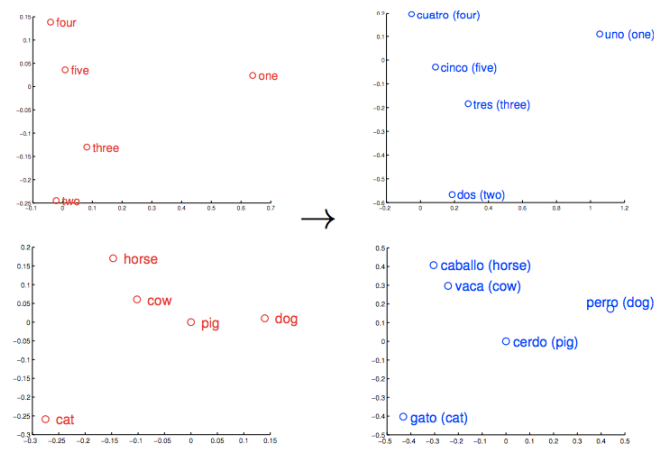

Main Source
https://stanfy.com/blog/advanced-natural-language-processing-tools-for-bot-makers/